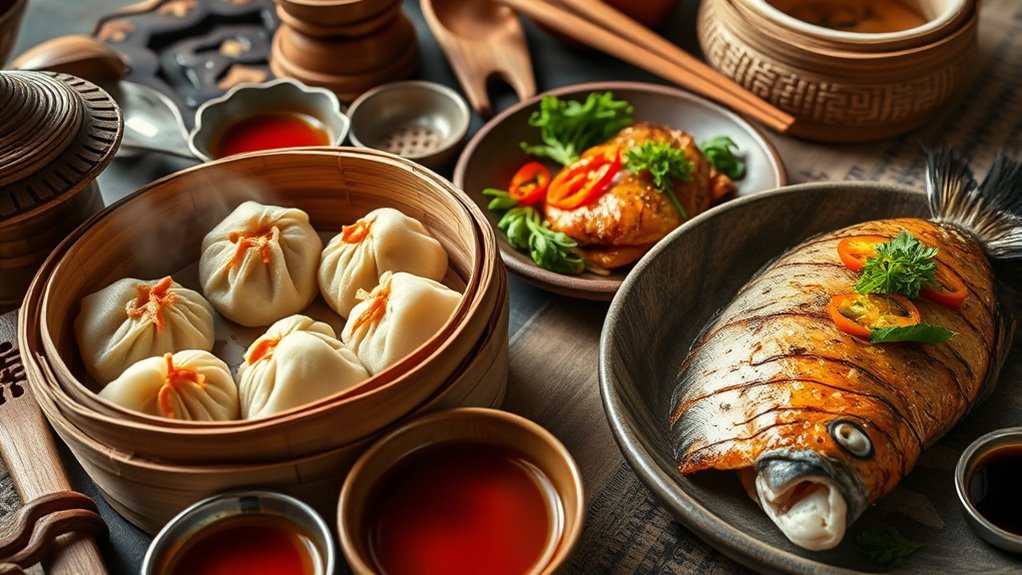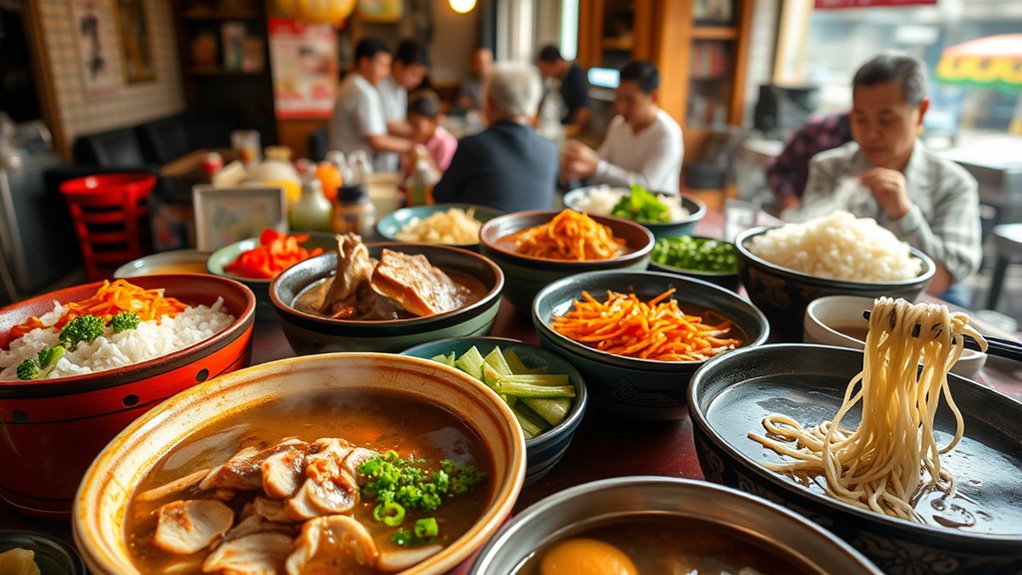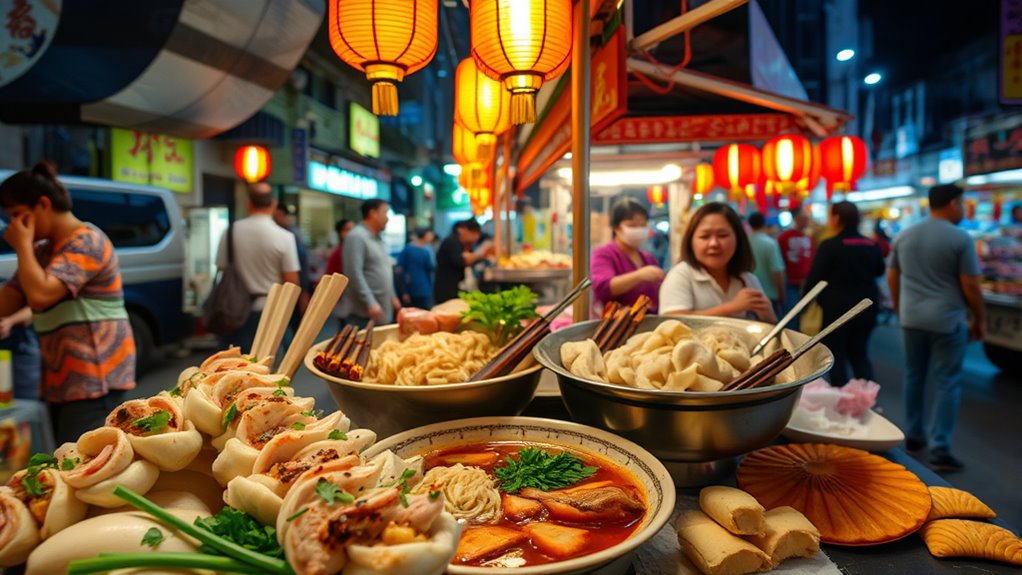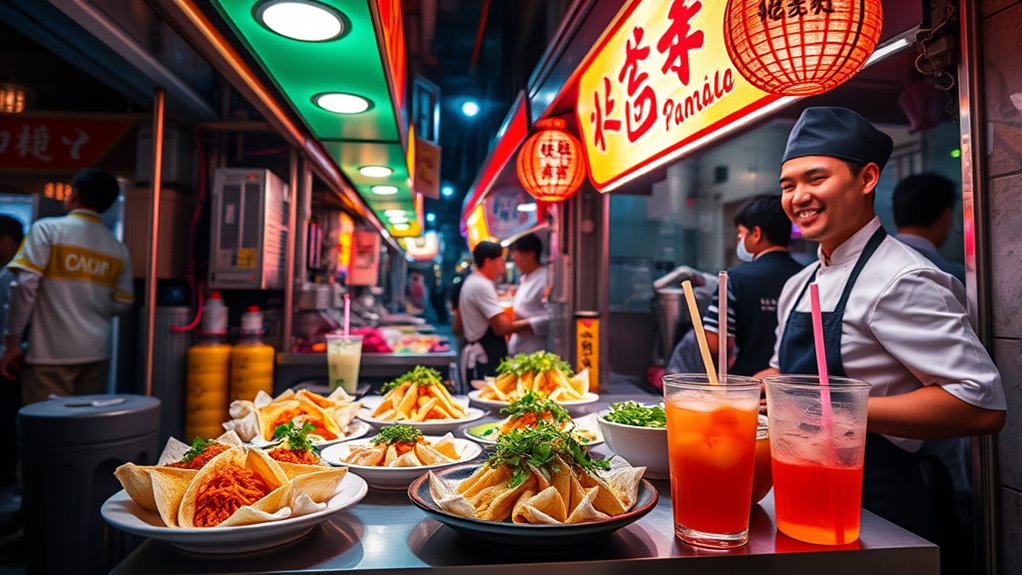Taiwan’s cuisine blends indigenous traditions, Chinese influences, and modern trends to create a vibrant food scene. You’ll find staples like rice, noodles, and fresh vegetables prepared with simple techniques that highlight natural flavors. Traditional dishes often include wild plants, millet, and preserved ingredients, while regional specialties showcase local produce and flavors. Street markets burst with fusion eats and innovative twists—if you want to explore more, you’ll discover the rich history behind every bite.
Key Takeaways
- Taiwan’s cuisine blends indigenous, Chinese, Japanese, and Western influences with a focus on fresh, regional ingredients and traditional cooking techniques.
- Indigenous foods emphasize land-based ingredients like wild plants, mountain vegetables, and millet, prepared through steaming, grilling, and fermenting.
- Staple ingredients include unique rice varieties, locally grown vegetables, and wild meats, reflecting Taiwan’s agricultural and cultural heritage.
- Popular dishes feature noodles, rice bowls, soups, and street foods, highlighting techniques like stir-frying, pickling, and braising.
- Modern trends incorporate fusion cuisine, street food innovation, and preservation methods, creating a diverse and dynamic culinary scene.
Indigenous Culinary Heritage and Signature Dishes

Taiwan’s indigenous culinary heritage offers a rich tapestry of unique flavors and traditional techniques that set it apart from Han Chinese-influenced cuisine. You’ll discover bold tastes like mountain peppercorns, which add a distinctive spiciness to many dishes. The Amis tribe’s alivongvong, a sticky rice and meat dumpling wrapped in leaves, exemplifies their emphasis on natural ingredients and simple preparation. The Atayal tribe specializes in grilled meats on heated stones and steaming rice cakes called langying. Millet-based foods are central to tribes like the Bunun, producing millet cakes and rice. Other tribes incorporate wild plants, bamboo, and wild meats into their signature dishes, often using grilling or steaming methods. These traditions highlight a deep connection to the land and local resources. Additionally, traditional cooking tools and teaware play an important role in preserving these culinary practices.
Staple Ingredients and Regional Produce

You’ll find that local rice varieties, especially those from Hualien and Taitung, are central to Taiwanese meals, offering distinct flavors and textures. Regional vegetables like cabbage, eggplants, and taro play a key role in creating diverse dishes across the island. By exploring these ingredients, you’ll see how Taiwan’s culinary landscape reflects its unique geography and local harvests. Additionally, understanding the natural techniques for seed production can provide insights into the sustainable farming practices behind some of these regional ingredients.
Local Rice Varieties
Have you ever wondered what makes Taiwanese rice dishes stand out? It’s the region’s dedication to cultivating specific local rice varieties that bring unique flavors and textures to your plate. In Taiwan, rice isn’t just a staple; it’s a symbol of local pride. The prized grains from Hualien and Taitung stand out for their aroma, stickiness, and consistency, perfect for dishes like sticky rice dumplings and rice bowls. Indigenous varieties, such as millet-based rice, add a nutty flavor, highlighting Taiwan’s rich agricultural heritage. These local strains adapt to Taiwan’s climate, ensuring freshness and quality. Additionally, the heartfelt cultural significance of rice cultivation underscores its importance in Taiwanese society. Whether used in everyday meals or special dishes, these rice varieties provide the foundation for the island’s diverse culinary traditions. Their distinct characteristics help shape Taiwan’s unique rice-based cuisine.
Regional Vegetable Highlights
Fresh, locally grown vegetables form the backbone of Taiwanese cuisine, showcasing regional diversity and seasonal abundance. You’ll find vegetables like cabbage, cauliflower, broccoli, eggplants, carrots, and potatoes used across the island, often prepared simply to highlight their natural flavors. Mung bean sprouts are common in stir-fries and soups, adding crunch and freshness. In southern Taiwan, sweeter vegetables like taro and sweet potatoes feature prominently, while the mountainous regions emphasize wild greens and bamboo shoots. Regional markets burst with seasonal produce, reflecting Taiwan’s rich agricultural heritage. Indigenous tribes incorporate wild plants and mountain vegetables into their traditional dishes, often using steaming or grilling methods. These regional vegetables help shape Taiwan’s vibrant, balanced, and seasonally driven culinary landscape. Incorporating local, seasonal ingredients not only preserves traditional flavors but also supports sustainable farming practices.
Influences Shaping Taiwanese Food Culture

Taiwan’s food culture has been shaped by a rich tapestry of influences, blending indigenous traditions with waves of migration and foreign rule. You can see this in:
- The strong Chinese influence, especially from Fujian and other southern provinces, bringing noodles, soy-based sauces, and stir-fry techniques.
- Japanese impact from the colonial period, introducing flavors like tempura, curry, and tea culture.
- Regional diversity, where local ingredients and preservation methods reflect historical scarcity and adaptation, creating specialties like Hsinchu rice noodles and Tainan seafood.
- The use of natural ingredients that emphasize freshness and seasonal availability, further enriching the culinary landscape.
Traditional Cooking Techniques and Flavor Profiles

You’ll find that Taiwanese cooking emphasizes balancing flavors with gentle seasoning, often highlighting natural ingredients. Techniques like stir-frying, pickling, and steaming preserve freshness while adding depth to dishes. By combining traditional methods with careful seasoning, Taiwanese cuisine creates harmonious and memorable flavor profiles. Additionally, the use of traditional techniques in Taiwanese cooking fosters a sense of cultural continuity and culinary authenticity.
Flavor Balancing and Seasoning
Traditional Taiwanese cooking masterfully balances flavors through careful seasoning and cooking techniques that highlight natural ingredients. You’ll notice that dishes often blend savory, sweet, and umami notes harmoniously. To achieve this, consider these key elements:
- Use soy sauce and garlic to enhance depth without overpowering the dish.
- Incorporate a splash of rice wine or a touch of sugar to balance acidity and sweetness.
- Rely on fresh herbs and wild plants to add brightness and complexity.
This approach emphasizes natural flavors while avoiding excessive salt or spice. The result is a cuisine that’s savory yet subtly sweet, with a layered umami profile. Mastering seasoning in Taiwanese dishes means respecting the ingredients’ integrity and creating a balanced, flavorful experience.
Cooking Methods and Preservation
Cooking methods in Taiwan reflect a long history of ingenuity and adaptation, shaping the vibrant flavors and textures found in its cuisine. You’ll find techniques like stir-frying, steaming, boiling, and grilling, often used to preserve freshness and enhance natural flavors. Pickling is also common, especially for vegetables and seasonal produce, developed during times of scarcity. Steaming and braising are favored for delicate meats and rice dishes, while grilling, especially over hot stones, highlights indigenous traditions. Preservation methods such as drying and fermenting extend ingredients’ shelf life and deepen flavors. These techniques emphasize balance and natural tastes, with soy sauce, garlic, and rice wine adding savory notes. The focus remains on highlighting the ingredient’s freshness, making each dish both flavorful and respectful of Taiwan’s culinary heritage. Additionally, fermentation plays a key role in developing complex umami flavors, as seen in traditional condiments like soy paste and pickled vegetables.
The Role of Noodles, Rice, and Soups in Daily Meals

Noodles, rice, and soups form the cornerstone of daily meals in Taiwan, providing the foundation for both everyday eating and special occasions. You’ll find these staples in almost every meal, shaping the island’s food culture. Here are three key ways they play an essential role:
Noodles, rice, and soups are the heart of Taiwan’s daily and festive meals.
- Noodles: Served in various forms like beef noodle soup or cold sesame noodles, they represent comfort and tradition.
- Rice: As the primary carbohydrate, rice is eaten plain or as a side with stir-fries, grilled meats, or soups.
- Soups: Thin broths, often flavored with soy, garlic, or herbs, accompany meals, offering warmth and balance.
Together, these ingredients create a harmonious, adaptable base that reflects Taiwan’s diverse culinary influences. Incorporating traditional cooking techniques ensures these staples remain flavorful and authentic.
Vegetarian and Vegan Food Traditions

In Taiwan, vegetarian and vegan food traditions are deeply rooted in cultural and religious practices, especially among Buddhist communities. You’ll find many temples offering plant-based dishes that emphasize fresh, natural ingredients and simple preparations. Vegan versions of classic Taiwanese dishes are common, featuring alternatives like tofu, mushrooms, and vegetables to replicate meat flavors. Vegan restaurants are widespread, showcasing creative dishes that highlight umami and balance flavors without animal products. These culinary traditions prioritize purity and mindfulness, often using herbal and wild ingredients. You’ll notice that vegetarian and vegan foods are seamlessly integrated into everyday cuisine, from street stalls to upscale eateries, reflecting a cultural commitment to compassion and health. This vibrant food scene celebrates flavor, tradition, and the island’s spiritual heritage. Additionally, the use of herbs and wild ingredients enhances the flavor profile while aligning with principles of natural and mindful eating.
Famous Regional Specialties and Local Flavors

Taiwan’s diverse landscape and rich cultural history give rise to a variety of regional specialties that showcase local flavors and ingredients. When you explore Taiwan’s culinary scene, you’ll notice distinct dishes reflecting each area’s unique resources. For example:
- In Tainan, you’ll find Milk Fish—a local delicacy simmered in savory broth with fresh herbs.
- In Hsinchu, Rice Noodles shine, known for their chewy texture and subtle seasoning that highlights regional ingredients.
- In Yilan, spring onions are a star, used in dishes like Yilan Spring Onion Pancakes, blending freshness with crispness.
- The use of holistic approaches in traditional Taiwanese cooking emphasizes balance and harmony of flavors, reflecting broader wellness philosophies.
These specialties emphasize local ingredients and cooking styles, giving you a taste of Taiwan’s regional diversity and culinary pride.
Food Preservation and Innovative Preparation Methods

Food preservation has played a crucial role in shaping Taiwanese culinary traditions, especially in times of scarcity and war. You’ll find methods like pickling vegetables, fermenting soy products, and drying meats widely used to extend shelf life. For example, salted and fermented vegetables add depth to dishes and last through harsh seasons. Innovative techniques like smoking pork or drying wild herbs are common to intensify flavors and preserve ingredients. You might also encounter unique preparation styles such as bamboo-cooked rice or grilled meats on hot stones, which maximize flavor and minimize spoilage. These methods reflect a resourceful approach, blending traditional practices with modern ingenuity to maintain freshness and create complex flavors. Such techniques continue to influence Taiwan’s diverse cuisine, balancing preservation with creative culinary innovation.
Urban Food Scenes and Street Market Delights

Street markets and night bazaars pulse at the heart of Taiwan’s vibrant urban culinary scene, offering an irresistible array of traditional and modern flavors. As you explore, you’ll encounter:
Discover Taiwan’s lively street markets, bursting with traditional and modern flavors.
- Food stalls serving steaming bowls of beef noodle soup, fragrant with spices and tender meat.
- Vendors selling skewers of grilled meats and seafood, seasoned with herbs and smoky charcoal.
- Sweet treats like bubble tea, shaved ice topped with fresh fruit, and colorful pastries.
You’ll find bustling crowds, lively chatter, and the aroma of frying and roasting filling the air. Each stall showcases local ingredients, quick preparation, and inventive twists on classic dishes. These markets are a sensory journey that captures Taiwan’s dynamic street food culture.
Fusion and Contemporary Trends in Taiwanese Cuisine

As Taiwan’s culinary scene continues to evolve, chefs and entrepreneurs are blending traditional flavors with global influences to create innovative dishes that appeal to diverse tastes. You’ll notice fusion cuisines combining indigenous ingredients, Sichuan spices, Japanese techniques, and Western trends, resulting in exciting new flavors. You might try a sushi roll with Taiwanese wild herbs or a burger topped with braised pork belly and pickled vegetables. This blending fosters creativity and broadens culinary appeal. The following ideas highlight some fusion concepts:
| Fusion Ideas | Description |
|---|---|
| Indigenous + Japanese | Using wild herbs in tempura |
| Western + Taiwanese | Craft beer brewed with local rice |
| Global + Local | International street food with Taiwanese twists |
Frequently Asked Questions
How Do Indigenous Ingredients Influence Modern Taiwanese Dishes?
You’ll notice that indigenous ingredients strongly influence modern Taiwanese dishes by adding unique flavors and local authenticity. Ingredients like mountain peppercorns, wild vegetables, millet, and bamboo are incorporated into contemporary recipes, creating a blend of traditional and modern tastes. These native elements often highlight the freshness of local ingredients and reflect cultural heritage, enriching dishes with distinctive flavors that resonate across Taiwan’s diverse culinary landscape.
What Are the Traditional Cooking Utensils Used in Taiwanese Indigenous Cuisine?
You’ll find that traditional Taiwanese indigenous cooking utensils paint a vivid picture of their heritage. You might use stone grills or hot stones for grilling meat, which is like turning back the clock. Wooden paddles and carved stone mortars for pounding or grinding ingredients are common. Bamboo baskets and steaming pots made from clay or bamboo help prepare mountain vegetables and sticky rice, giving each dish a genuine, earthy touch.
How Do Seasonal Changes Affect Ingredient Availability and Meal Preparation?
You’ll notice that seasonal changes greatly influence ingredient availability and meal prep. In spring and summer, fresh vegetables like eggplants, tomatoes, and wild greens become abundant, inspiring lighter, vegetable-focused dishes. During fall and winter, root vegetables, preserved foods, and preserved meats take center stage, making hearty stews and pickled items. You adapt by using seasonal ingredients, preserving surplus, and adjusting flavors to match the changing climate, ensuring meals remain flavorful and fresh year-round.
What Role Do Religious Practices Play in Shaping Food Traditions?
Think of religion as the compass guiding Taiwanese food traditions. You’ll find that Buddhist practices inspire a vibrant vegan and vegetarian scene, emphasizing fresh, natural ingredients and simple preparations. Temples often host vegetarian banquets, shaping local culinary customs. Festivals and rituals also influence ingredient choices and meal timing, creating a harmonious balance between faith and flavor that deeply embeds spirituality into everyday eating habits.
How Is Taiwanese Street Food Evolving With Global Culinary Trends?
You’ll notice Taiwanese street food evolves by blending traditional flavors with global culinary trends. Vendors experiment with international ingredients, fusion dishes, and modern presentation, attracting diverse crowds. Food markets incorporate Asian, European, and American influences, offering innovative twists on classics like beef noodles or bubble tea. This dynamic adaptation keeps street food vibrant, appealing to both locals and tourists seeking authentic yet contemporary flavors, making Taiwan’s street scene an exciting culinary hub.
Conclusion
You can’t escape Taiwan’s culinary magic—it’s an unstoppable force that transforms every meal into a burst of flavor, a symphony of tradition and innovation, and a celebration of culture that leaves your taste buds begging for more. From bustling street markets to modern restaurants, Taiwanese cuisine is an exhilarating adventure you’ll never forget. Immerse yourself, savor every bite, and let this incredible food scene take over your senses in the most unforgettable way!









